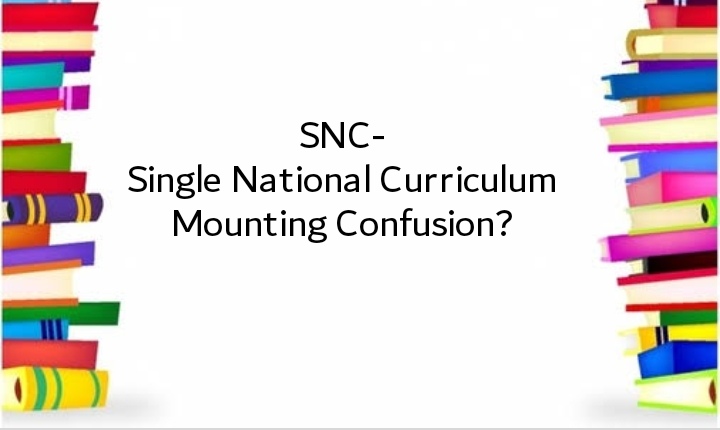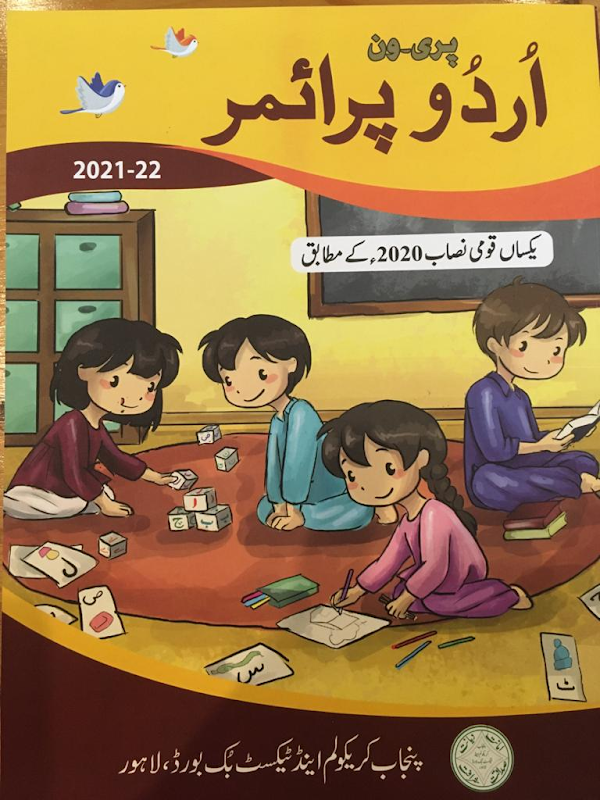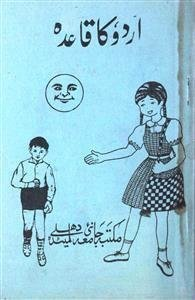
[Introduction to Series: Dr. Anjum Altaf, former Dean of the School of Humanities and Social Sciences at LUMS, is writing a page-by-page review of the model textbooks (Pre-I to Grade 5) accompanying the recently implemented Single National Curriculum. These detailed reviews intended to involve parents in the education of their children will appear as a series in Sindh Courier. Parents would benefit by having a copy of the primer under discussion in front of them while reading the review.]
SNC Model Textbooks: Pre-I Urdu Primer — I
By Dr. Anjum Altaf
I looked at the cover of the Pre-I Urdu primer for quite some time. I will let you do so as well before I comment on what caught my eye and move on to the review. Consider this the pre-I part.
 You can see the title of the primer — پری۔ون اُردُو پرائمر. Alongside is the school year, 2021-22, and at the bottom of the page is the name of the issuing authority: پنجاب کریکولم اینڈ ٹیکسٹ بک بورڈ ۰ لاہور.
You can see the title of the primer — پری۔ون اُردُو پرائمر. Alongside is the school year, 2021-22, and at the bottom of the page is the name of the issuing authority: پنجاب کریکولم اینڈ ٹیکسٹ بک بورڈ ۰ لاہور.
Leaving aside the names of the language, the province, and the city, which are of lowly native origin, every other term is an English one written in Urdu script — ‘Pre-I,’ ‘Primer,’ ‘Curriculum,’ Textbook,’ and ‘Board.’ The date is also written in the English manner — 2021-22.
What subliminal message would this convey to children entering school to learn Urdu? That their national language is so impoverished that it is unable to express the most basic things in its own vocabulary? That an official agency in the country doesn’t feel the need to have the equivalent of its name in a local language? Talk about being enslaved by English! (Note, that in a place with a sense of dignity and service, it should actually be the other way around — the original name should be in a local language with a translation in English or any other language, as needed. This confirms that communication is directed upwards, not downwards as it ought.) What, one may wonder, is the point of learning a language that is so incredibly deficient or is considered as such by those who are nevertheless so keen to teach it?
With this kind of treatment of the language, I am not surprised that in the village I visited most recently, I saw signs for بِلّا برگر پوائنٹ and بسم اللہ جوس کارنر. Is this the future of Urdu we are preparing our next generations for? Or is Urdu being taught not for its functionality but to transmit the great heritage of Ghalib and Faiz? If the latter, I have some news to share. In another village I visited earlier, I was accosted by an incredibly bright ninth-grader. After chatting for quite some time, I offered to mail my books on Ghalib and Faiz written for students like him. “Uncle,” he exclaimed, no one reads Ghalib and Faiz these days, they are so old-fashioned” and proceeded to mention the names of some rap poets who were all the rage amongst his peers. Incidentally, he wished when he was older to be either a commando or a real-estate broker. I pray the amnesty lasts till then.
This is a serious question: What are we teaching Urdu for when it is not respected by those who claim to be its major proponents, when the majority is not given the vocabulary to benefit from its heritage, and when it is continuously losing ground for functional purposes? Couldn’t the time saved be better allocated to something more useful? Teachers could help children make EVMs with low cost / no cost materials. They could be designed to bounce back when thrown.
Is it really impossible to handle the terms on the cover of the primer that have proved insurmountable for the کریکولم اینڈ ٹیکسٹ بک بورڈ? To start with, does it really require a quantum leap of ingenuity to render 2021-22 on the cover of an Urdu primer as ۲۰۲۱-۲۲? It doesn’t, but this is the crippling fallout of having the Pre-I Mathematics Primer in English on account of the mad rush to catch up with the advanced world while moving backwards.
What about پرائمر? A perfectly sensible term with an extended usage is قاعدہ. Here is a cover from the مکتبہِ جامعہ نئی دہلی that shows it is quite doable:
 In this New Pakistan, Pre-I (پری۔ون), has vanquished our کریکولم اینڈ ٹیکسٹ بک بورڈ and appears beyond its ability. Pre-I is almost universally referred to in Pakistan as کچّی or کچّی جماعت but if one really wanted to be stuffed one could label it as قبل از اوّل جماعت. Given that the name has to relate to children, I would go with اُردُو کا پہلا قاعدہ or
In this New Pakistan, Pre-I (پری۔ون), has vanquished our کریکولم اینڈ ٹیکسٹ بک بورڈ and appears beyond its ability. Pre-I is almost universally referred to in Pakistan as کچّی or کچّی جماعت but if one really wanted to be stuffed one could label it as قبل از اوّل جماعت. Given that the name has to relate to children, I would go with اُردُو کا پہلا قاعدہ or
کچّی جماعت کے لئے اُردُو قاعدہ.
What about the venerable کریکولم اینڈ ٹیکسٹ بک بورڈ itself that has not been able to figure out a local name in over 70 years? Or has it simply not bothered? How about ادارہ برائے نصاب اور درسی کتب? Uff! Wasn’t that herculean task exhausting?
I will proceed to the review با دلِ نخواستہ. Perhaps I should write that as اَنوِلِنگلی for the dignitaries of the پنجاب کریکولم اینڈ ٹیکسٹ بک بورڈ ۰ لاہور?
[author title=”Dr. Anjum Altaf ” image=”https://sindhcourier.com/wp-content/uploads/2021/05/Anjum-Altaf.jpg”]Dr. Anjum Altaf is the former Dean of the School of Humanities and Social Sciences at LUMS. He is the author of Plain Truths About Early Childhood Education: Letters to Parents (available as an e-book from Little Books) and of Critical Reflections on the Single National Curriculum and the Medium of Instruction (forthcoming).[/author]
Click here for Part-I , Part-II, Part-III, Part-IV, Part-V, Part-VI, Part-VII, Part-VIII, Part-IX, Part-X, Part-XI